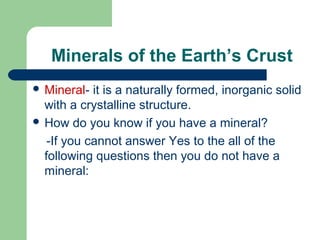
Obj 1 compare rocks and minerals
- 1. Minerals of the Earth’s Crust Mineral- it is a naturally formed, inorganic solid with a crystalline structure. How do you know if you have a mineral? -If you cannot answer Yes to the all of the following questions then you do not have a mineral:
- 2. Questions Is it a solid? Is it formed in nature? Does it have a crystalline structure? Is it nonliving material?
- 3. What are they made of? Mineralsare made of elements. Each element is made of only one kind of atom. Most minerals are made of compounds of different elements.
- 4. Crystals They are solid, geometric forms of minerals produced by a repeating pattern of atoms that is present throughout the mineral.
- 5. Types of Minerals SilicateMinerals-Minerals that contain a combination of the elements silicon and oxygen. NonsilicateMinerals-Minerals that do not contain compounds of silicon and oxygen.
- 6. Identifying Minerals There are many ways to identify a mineral. Some of the ways are to look at their color, luster, streak, cleavage, fracture, hardness, and density.
- 7. Identifying Cont. Color-similar minerals can come in different colors. Color is not a reliable indicator of a mineral’s identity. Luster-The way a surface reflects light.
- 8. Identifying Cont. Streak-thecolor of a mineral in powdered form. Cleavage-The tendency of some minerals to break along flat surfaces. Fracture-The tendency of some minerals to break unevenly along curved or irregular surfaces.
- 9. Identifying Cont. Hardness-A mineral’s resistance to being scratched. Density-A measure of how much matter there is in a given amount of space.
- 10. Formation of Minerals Almost all minerals can be found in the Earth’s crust. They are formed in many different environments. - Heat - Volcanic activity - Presence of ground water - Pressure